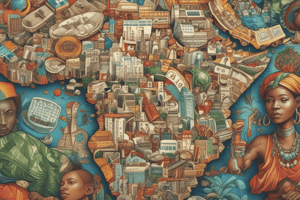Podcast
Questions and Answers
What is a defining characteristic of capitalism?
What is a defining characteristic of capitalism?
- State regulation of market prices
- Private ownership of capital goods (correct)
- Emphasis on subsistence farming
- Government ownership of production
Which of the following best describes a mixed economy?
Which of the following best describes a mixed economy?
- Economic activities driven by individual customs only
- Combination of private and public sector involvement (correct)
- Communities relying solely on barter for exchange
- Total government control of economic activities
In a traditional economy, how are goods and services typically exchanged?
In a traditional economy, how are goods and services typically exchanged?
- Via stock market investments
- By government regulation
- Using a barter system (correct)
- Through currency transactions
What is a common characteristic of command economies?
What is a common characteristic of command economies?
Which of the following countries is an example of a capitalist economy?
Which of the following countries is an example of a capitalist economy?
What role does government play in a mixed economy?
What role does government play in a mixed economy?
Which key feature is characteristic of traditional economies?
Which key feature is characteristic of traditional economies?
In command economies, what is the impact on consumer choice?
In command economies, what is the impact on consumer choice?
Flashcards are hidden until you start studying
Study Notes
Types of Economies
1. Capitalism
- Definition: An economic system where private individuals or businesses own capital goods.
- Key Features:
- Free markets: Prices determined by supply and demand.
- Competition: Encourages innovation and efficiency.
- Profit motive: Businesses operate to generate profit.
- Limited government intervention: Minimal regulation and control by the state.
- Examples: United States, Canada, Australia.
2. Mixed Economies
- Definition: An economic system combining elements of capitalism and socialism.
- Key Features:
- Coexistence of private and public sectors: Both private businesses and government play roles in the economy.
- Regulation: Government intervenes to correct market failures and promote social welfare.
- Welfare policies: Social programs to support the disadvantaged.
- Examples: Sweden, France, Japan.
3. Traditional Economies
- Definition: Economic systems based on customs, traditions, and beliefs.
- Key Features:
- Subsistence farming: Communities produce just enough for their own needs.
- Barter system: Goods and services are exchanged directly without money.
- Stability: Slow change, with economic roles often inherited and dictated by culture.
- Examples: Indigenous groups, rural communities in developing countries.
4. Command Economies
- Definition: An economic system where the government makes all economic decisions.
- Key Features:
- Central planning: Government determines what to produce, how to produce, and for whom to produce.
- Lack of personal choice: Limited consumer choices, as production is dictated by the state.
- State ownership: Major industries and resources are owned by the government.
- Examples: North Korea, former Soviet Union.
Capitalism
- An economic system characterized by private ownership of capital goods.
- Prices are determined by free market principles of supply and demand.
- Encourages competition, driving innovation and efficiency in the market.
- Businesses operate primarily to generate profit, influencing their decision-making.
- Government intervention is minimal, allowing for a largely unregulated marketplace.
- Notable examples include the United States, Canada, and Australia.
Mixed Economies
- Combines elements of both capitalism and socialism for economic functioning.
- Recognizes the coexistence of private enterprises and public sector involvement.
- Government plays a regulatory role to address market failures and ensure social welfare.
- Includes welfare policies and social programs aimed at supporting disadvantaged populations.
- Examples of mixed economies can be found in Sweden, France, and Japan.
Traditional Economies
- Economic systems are influenced by cultural customs, traditions, and beliefs.
- Subsistence farming is prevalent, where communities grow only enough food for their needs.
- Utilizes a barter system for trade, exchanging goods and services directly without monetary transactions.
- Change occurs gradually, with economic roles typically inherited and shaped by cultural norms.
- Common in indigenous groups and rural communities within developing countries.
Command Economies
- Characterized by government control over all economic decisions and activities.
- Central planning dictates production, including what, how, and for whom goods are produced.
- Consumer choice is significantly restricted, limiting the variety in available goods and services.
- Major industries and natural resources are owned and managed by the state.
- Notable examples include North Korea and the former Soviet Union.
Studying That Suits You
Use AI to generate personalized quizzes and flashcards to suit your learning preferences.




